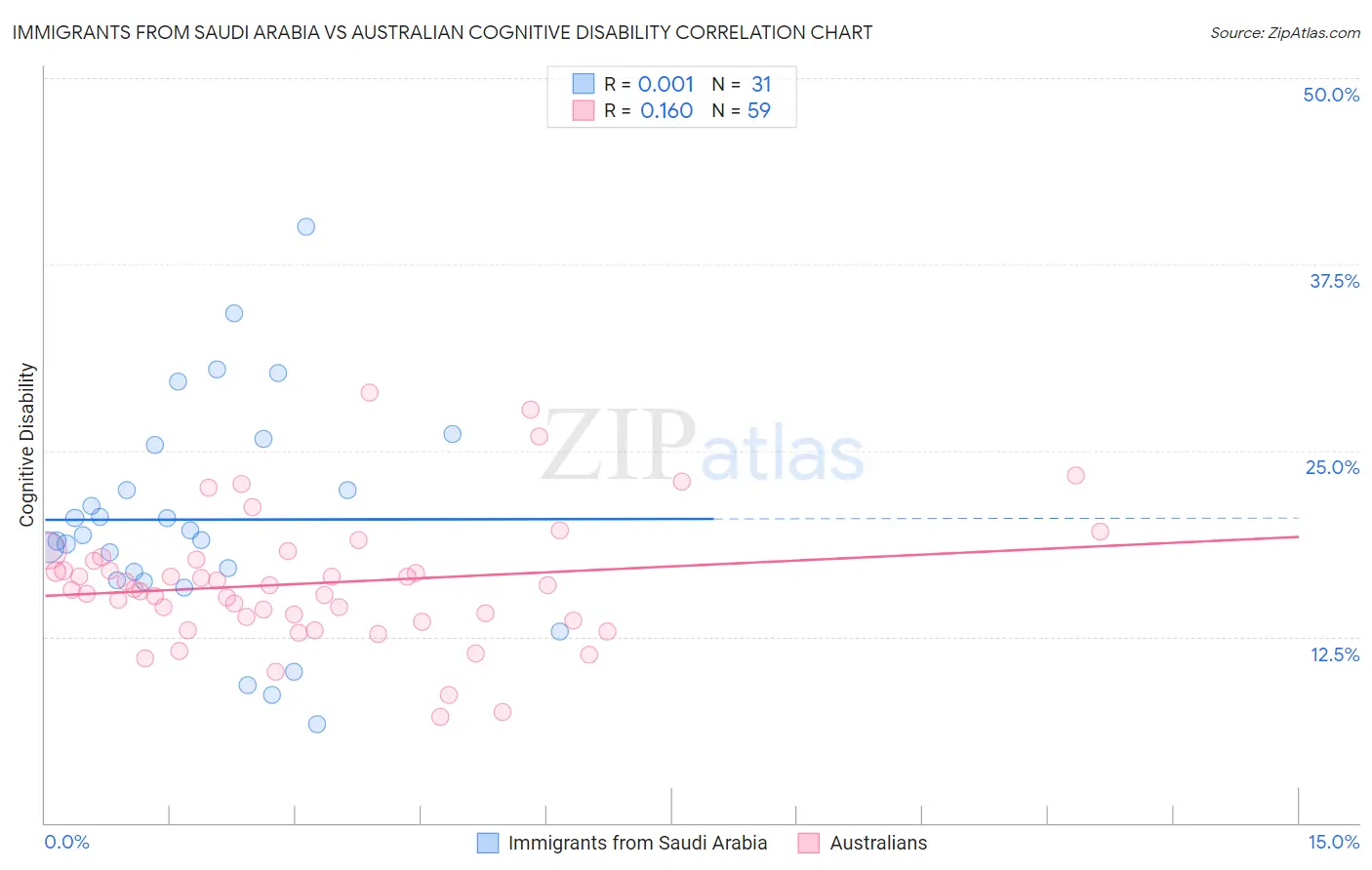Immigrants from Saudi Arabia vs Australian Cognitive Disability
COMPARE
Immigrants from Saudi Arabia
Australian
Cognitive Disability
Cognitive Disability Comparison
Immigrants from Saudi Arabia
Australians
19.1%
COGNITIVE DISABILITY
0.0/ 100
METRIC RATING
337th/ 347
METRIC RANK
17.2%
COGNITIVE DISABILITY
72.4/ 100
METRIC RATING
160th/ 347
METRIC RANK
Immigrants from Saudi Arabia vs Australian Cognitive Disability Correlation Chart
The statistical analysis conducted on geographies consisting of 164,285,964 people shows no correlation between the proportion of Immigrants from Saudi Arabia and percentage of population with cognitive disability in the United States with a correlation coefficient (R) of 0.001 and weighted average of 19.1%. Similarly, the statistical analysis conducted on geographies consisting of 224,142,484 people shows a poor positive correlation between the proportion of Australians and percentage of population with cognitive disability in the United States with a correlation coefficient (R) of 0.160 and weighted average of 17.2%, a difference of 11.1%.

Cognitive Disability Correlation Summary
| Measurement | Immigrants from Saudi Arabia | Australian |
| Minimum | 6.6% | 7.1% |
| Maximum | 40.0% | 28.9% |
| Range | 33.4% | 21.7% |
| Mean | 20.4% | 16.1% |
| Median | 19.3% | 15.7% |
| Interquartile 25% (IQ1) | 16.3% | 13.6% |
| Interquartile 75% (IQ3) | 25.4% | 17.7% |
| Interquartile Range (IQR) | 9.1% | 4.1% |
| Standard Deviation (Sample) | 7.4% | 4.3% |
| Standard Deviation (Population) | 7.3% | 4.3% |
Similar Demographics by Cognitive Disability
Demographics Similar to Immigrants from Saudi Arabia by Cognitive Disability
In terms of cognitive disability, the demographic groups most similar to Immigrants from Saudi Arabia are Black/African American (19.0%, a difference of 0.13%), Lumbee (19.1%, a difference of 0.34%), Senegalese (19.0%, a difference of 0.42%), Puerto Rican (19.2%, a difference of 0.82%), and Cape Verdean (19.2%, a difference of 0.84%).
| Demographics | Rating | Rank | Cognitive Disability |
| Immigrants | Dominican Republic | 0.0 /100 | #330 | Tragic 18.8% |
| Pima | 0.0 /100 | #331 | Tragic 18.8% |
| Immigrants | Sudan | 0.0 /100 | #332 | Tragic 18.8% |
| Immigrants | Yemen | 0.0 /100 | #333 | Tragic 18.8% |
| Sudanese | 0.0 /100 | #334 | Tragic 18.9% |
| Senegalese | 0.0 /100 | #335 | Tragic 19.0% |
| Blacks/African Americans | 0.0 /100 | #336 | Tragic 19.0% |
| Immigrants | Saudi Arabia | 0.0 /100 | #337 | Tragic 19.1% |
| Lumbee | 0.0 /100 | #338 | Tragic 19.1% |
| Puerto Ricans | 0.0 /100 | #339 | Tragic 19.2% |
| Cape Verdeans | 0.0 /100 | #340 | Tragic 19.2% |
| Tohono O'odham | 0.0 /100 | #341 | Tragic 19.3% |
| Houma | 0.0 /100 | #342 | Tragic 19.3% |
| Immigrants | Zaire | 0.0 /100 | #343 | Tragic 19.4% |
| Immigrants | Congo | 0.0 /100 | #344 | Tragic 19.7% |
Demographics Similar to Australians by Cognitive Disability
In terms of cognitive disability, the demographic groups most similar to Australians are American (17.2%, a difference of 0.010%), Immigrants from Latvia (17.2%, a difference of 0.030%), Yugoslavian (17.2%, a difference of 0.030%), Immigrants from Switzerland (17.2%, a difference of 0.030%), and Celtic (17.1%, a difference of 0.060%).
| Demographics | Rating | Rank | Cognitive Disability |
| Immigrants | Kazakhstan | 80.5 /100 | #153 | Excellent 17.1% |
| Immigrants | Malaysia | 79.3 /100 | #154 | Good 17.1% |
| Brazilians | 78.9 /100 | #155 | Good 17.1% |
| Sri Lankans | 78.9 /100 | #156 | Good 17.1% |
| Immigrants | Australia | 76.0 /100 | #157 | Good 17.1% |
| Celtics | 74.1 /100 | #158 | Good 17.1% |
| Immigrants | Latvia | 73.2 /100 | #159 | Good 17.2% |
| Australians | 72.4 /100 | #160 | Good 17.2% |
| Americans | 72.2 /100 | #161 | Good 17.2% |
| Yugoslavians | 71.6 /100 | #162 | Good 17.2% |
| Immigrants | Switzerland | 71.5 /100 | #163 | Good 17.2% |
| Armenians | 70.1 /100 | #164 | Good 17.2% |
| Immigrants | Albania | 64.9 /100 | #165 | Good 17.2% |
| Immigrants | Ecuador | 64.4 /100 | #166 | Good 17.2% |
| Immigrants | Syria | 63.5 /100 | #167 | Good 17.2% |